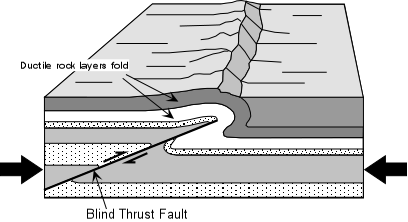
| EENS 2040 | Natural Disasters |
| Tulane University | Prof. Stephen A. Nelson |
Earthquake Case Histories |
|
Earthquake Case Histories For this lecture we will watch a video entitled "Killer Quake", produced by the Public Broadcasting System for their series, "Nova". The video is about the 1994 Northridge Earthquake (magnitude 6.7), that occurred just north of Los Angeles in the San Fernando Valley. It is an excellent summary of the material we have covered so far. It discusses the effects of this earthquake and other powerful earthquakes that have occurred in California, and shows the types of damage that occurred. It also discusses the actual causes of the earthquake, and efforts to improve earthquake prediction and monitoring. The video also introduces some new material that will first be discussed here.
The Northridge Earthquake did not occur along the San Andreas Fault, as most people
assume, but instead occurred along a buried fault called a blind thrust fault, because it
does not show up at the surface. A block diagram of a blind thrust fault is shown
below. |
|
The Origin of Blind Thrust Faults
|
|
 |
|
|
|
Questions on this material that could be asked on an exam Note that answers to some of these questions will come from the video
|